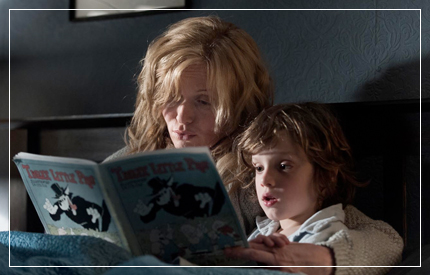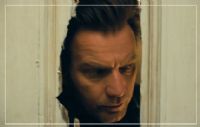The Babadook - You Can't Get Rid...
Date: 24/11/2014
Movie Review

Essie Davis plays Amelia, a single mother struggling to raise her hyperactive son, Samuel, played by Noah Wiseman, following the horrific death of her husband. Like most children, Samuel believes in monsters, and every night asks his mum to check the cupboards, under the bed, and anywhere else a ghost or ghoul is likely to be hiding.
Amelia knows his talk of bashing in monsters' heads is simply part of any kid's make-believe world; until, that is, Sam asks his mum to read him Mister Babadook, a children's book featuring macabre, ghastly drawings of its titular character stalking little children from behind the wardrobe door.
Despite protestations from his mother, Samuel becomes obsessed with the Babadook character, while at the same time becoming more aggressive and violent. Amelia turns to her GP and is prescribed sleeping pills for Samuel, in order that both of them can escape his nightly visits from the Babadook. But as the pair begin to catch up on their sleep, the lines between night and day, between dreams and reality, are blurred, and Amelia begins to wonder whether she, too, is being haunted by the demonic children’s character, or if she is beginning to lose her mind.
As with many other genres, any horror film put out by an indie production is likely to be worth a shot. October also saw the release of The Conjuring prequel Annabelle, for example, which achieves adequate levels of creepiness and jump-scares, but without truly investing in any worthwhile characters or interesting sub plot. Contrasting this increasingly prevalent, perfunctory popcorn horror are films like The Babadook, that manage to build an effective horror story around an original, inventive premise and characters in which the audience can invest.
The film throws us straight into the chaotic lives of a struggling single mum and her troubled son. While she attempts to hold down her job as a nurse in a care home, Amelia must also contend with Sam’s incessant and increasing hyperactivity, as he becomes an ever-growing threat to himself and those around him. Amelia finds herself and her child cut off from the rest of the world – friends stop calling, invitations dry up, authority figures offer only sceptical assistance at best, and Samuel eventually becomes too much to handle.
The story of the Babadook seems to make things worse, but try as she might, Amelia can't seem to get the story out of Samuel's head, until she turns to medication to help both of them sleep. But at this point, the film's depiction of reality begins to morph into dark, ethereal visions and nightmares of gothic terror, in which the Babadook monster stalks her and Samuel around the house.
Essie Davis essentially carries the bulk of the film on her shoulders, assisted of course by Noah Wiseman, who pulls off a startlingly realistic depiction of a small, misunderstood boy who just can't seem to help but distance those around him, including his mother. Davis looks thoroughly distraught and exhausted throughout the film, as someone who is still struggling to come to terms with the death of her husband seven years ago. She evokes sympathy initially, through her depiction of a single parent struggling in what is an increasingly desperate situation, but eventually becomes one of the film's most frightening characters, as the grip of the Babadook tightens.
The macabre and unsettling nature of the film is aided in no small part by a fairly drab and downbeat colour scheme. Greys, whites, blacks and deep blues fill the screen, while ominous establishing shots show nature and the surrounding environment as both jarring and threatening. This feeds nicely into the Babadook aesthetic, which essentially plays out as dark, gothic expressionism for children. Reportedly, the majority of the funds raised by a Kickstarter campaign for the film went towards the art department. It shows. The Mister Babadook book itself is not unlike some of the more quirky selections you might find in the children’s section at Waterstones, if perhaps a little too violent and macabre to ever have any possibility of being picked up by a publisher.
It is never fully explained as to where the book came from, or why Amelia and her son are singled out by the demon. There is, of course, the possibility that everything is simply a figment of the characters’ imaginations; an outward expression of mental anxieties triggered through the loss of their husband and father, exacerbated by Sam’s unruly behaviour and their consequent shunning from society. This, at least, would explain the use of expressionistic aesthetic throughout the film.
Amelia does find solace in her work colleague, Robbie, played by Daniel Henshaw, and their elderly next door neighbour Mrs Roach, played by Barbara West, who is suffering from Parkinson’s. They offer light relief and a little optimism for Amelia and Samuel, in what is an otherwise frightening and fairly downbeat storyline.
As the film reaches its conclusion, the Babadook becomes more intertwined in the lives of Amelia and Sam, to the point where the two characters turn on each other. The background story of the death of their husband and father comes to the fore, as the Babadook’s presence seems to invoke more and more pain, anger and fear related to the tragedy. But, of course, at the back of the audience’s mind is always the question as to which is causing which...
The Babadook is certainly one of the more subversive and inventive horror films to achieve a mainstream release this year; not just through the originality of its monster and impressive art design, but through its unsettling depiction of human relationships and the fact that its characters are fallible, three-dimensional creations. In terms of its effectiveness as a horror film, The Babadook has plenty of spine-tingling moments and effective jump-scares; the difference between it and many other mainstream releases being that it possesses the originality and inventiveness to truly pull it off.
Iain Todd
From issue 253 of our paper...
Amelia knows his talk of bashing in monsters' heads is simply part of any kid's make-believe world; until, that is, Sam asks his mum to read him Mister Babadook, a children's book featuring macabre, ghastly drawings of its titular character stalking little children from behind the wardrobe door.
Despite protestations from his mother, Samuel becomes obsessed with the Babadook character, while at the same time becoming more aggressive and violent. Amelia turns to her GP and is prescribed sleeping pills for Samuel, in order that both of them can escape his nightly visits from the Babadook. But as the pair begin to catch up on their sleep, the lines between night and day, between dreams and reality, are blurred, and Amelia begins to wonder whether she, too, is being haunted by the demonic children’s character, or if she is beginning to lose her mind.
As with many other genres, any horror film put out by an indie production is likely to be worth a shot. October also saw the release of The Conjuring prequel Annabelle, for example, which achieves adequate levels of creepiness and jump-scares, but without truly investing in any worthwhile characters or interesting sub plot. Contrasting this increasingly prevalent, perfunctory popcorn horror are films like The Babadook, that manage to build an effective horror story around an original, inventive premise and characters in which the audience can invest.
The film throws us straight into the chaotic lives of a struggling single mum and her troubled son. While she attempts to hold down her job as a nurse in a care home, Amelia must also contend with Sam’s incessant and increasing hyperactivity, as he becomes an ever-growing threat to himself and those around him. Amelia finds herself and her child cut off from the rest of the world – friends stop calling, invitations dry up, authority figures offer only sceptical assistance at best, and Samuel eventually becomes too much to handle.
The story of the Babadook seems to make things worse, but try as she might, Amelia can't seem to get the story out of Samuel's head, until she turns to medication to help both of them sleep. But at this point, the film's depiction of reality begins to morph into dark, ethereal visions and nightmares of gothic terror, in which the Babadook monster stalks her and Samuel around the house.
Essie Davis essentially carries the bulk of the film on her shoulders, assisted of course by Noah Wiseman, who pulls off a startlingly realistic depiction of a small, misunderstood boy who just can't seem to help but distance those around him, including his mother. Davis looks thoroughly distraught and exhausted throughout the film, as someone who is still struggling to come to terms with the death of her husband seven years ago. She evokes sympathy initially, through her depiction of a single parent struggling in what is an increasingly desperate situation, but eventually becomes one of the film's most frightening characters, as the grip of the Babadook tightens.
The macabre and unsettling nature of the film is aided in no small part by a fairly drab and downbeat colour scheme. Greys, whites, blacks and deep blues fill the screen, while ominous establishing shots show nature and the surrounding environment as both jarring and threatening. This feeds nicely into the Babadook aesthetic, which essentially plays out as dark, gothic expressionism for children. Reportedly, the majority of the funds raised by a Kickstarter campaign for the film went towards the art department. It shows. The Mister Babadook book itself is not unlike some of the more quirky selections you might find in the children’s section at Waterstones, if perhaps a little too violent and macabre to ever have any possibility of being picked up by a publisher.
It is never fully explained as to where the book came from, or why Amelia and her son are singled out by the demon. There is, of course, the possibility that everything is simply a figment of the characters’ imaginations; an outward expression of mental anxieties triggered through the loss of their husband and father, exacerbated by Sam’s unruly behaviour and their consequent shunning from society. This, at least, would explain the use of expressionistic aesthetic throughout the film.
Amelia does find solace in her work colleague, Robbie, played by Daniel Henshaw, and their elderly next door neighbour Mrs Roach, played by Barbara West, who is suffering from Parkinson’s. They offer light relief and a little optimism for Amelia and Samuel, in what is an otherwise frightening and fairly downbeat storyline.
As the film reaches its conclusion, the Babadook becomes more intertwined in the lives of Amelia and Sam, to the point where the two characters turn on each other. The background story of the death of their husband and father comes to the fore, as the Babadook’s presence seems to invoke more and more pain, anger and fear related to the tragedy. But, of course, at the back of the audience’s mind is always the question as to which is causing which...
The Babadook is certainly one of the more subversive and inventive horror films to achieve a mainstream release this year; not just through the originality of its monster and impressive art design, but through its unsettling depiction of human relationships and the fact that its characters are fallible, three-dimensional creations. In terms of its effectiveness as a horror film, The Babadook has plenty of spine-tingling moments and effective jump-scares; the difference between it and many other mainstream releases being that it possesses the originality and inventiveness to truly pull it off.
Iain Todd
From issue 253 of our paper...




































